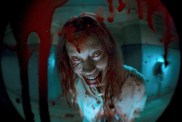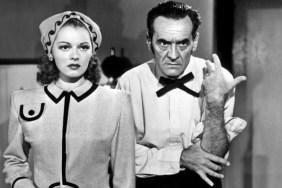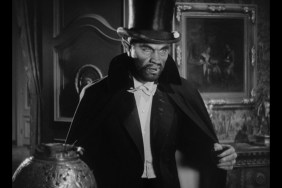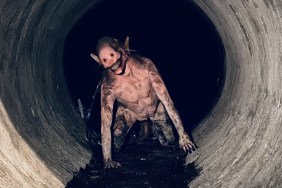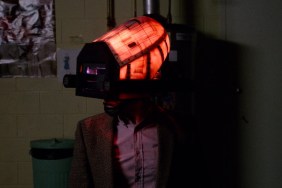
Macbeth was the first film Roman Polanski made following the murder of his wife, Sharon Tate, and friends at the hands of the Manson family. At the time he’d been working on the sci-fi thriller The Day of the Dolphin, which would later be made by Mike Nichols. It was during a skiing trip arranged by Victor Lownes, a subsequent producer of the film, Polanski made the decision Macbeth would be his next film. It was a decision he made feeling his next film “should be something serious, not a comedy… something with some depth.”
Polanski would team with Kenneth Tynan to write the screenplay and, thanks to urging from Lownes, Hugh Hefner and Playboy would eventually serve as the film’s producer after no one else would touch it. As Polanski notes in an included 60-minute documentary on this new Criterion Blu-ray release, to that point there had only been a couple of major adaptations of Shakespeare’s “Macbeth” on the big screen, one was Akira Kurosawa‘s Throne of Blood and the other being Orson Welles‘ 1948 adaptation and he felt there was room for his own take on the material.
Polanski notes he doesn’t consider Welles’ version to necessarily be that great and perhaps one of the famed director’s lesser features while Kurosawa’s was an adaptation that turned the story into a samurai film. He saw the feature as a chance to fill a void left open and on a budget of nearly £2 million he fought the weather in the British Isles and put together a wonderful cast for an equally wonderful film, though it did take me a little while to warm to it.
I came to realize something watching Polanski’s version of the story, a recognition that walking in to a Shakespeare adaptation the filmmaker is at a disadvantage, particularly if we’re talking about one of Shakespeare’s more well-known plays. We already know the story and depending on our relationship with the material, we may already have our own vivid impression of how the story and characters should play out and look.
When it comes to Polanski’s treatment of the material, he is very straight-forward. There’s no attempt to update it, instead he sets it squarely in the early 1600s, telling of the titular Scottish general, and the prophecy he receives that he will one day be the King of Scotland. We know the story, we know how it’s going to turn out and no amount of impressive production and costume design is going to elevate the story. Polanski and Tynan also stick to using Shakespeare’s prose, but this is where the film finds its first bit of footing and ventures into elevating the material beyond something we recognize, becoming something all its own.
Polanski has the actors recite the lines as if it’s their natural way of speaking. He doesn’t ask them to play the characters as if they are reading Shakespeare, he asks they become characters that speak the language of Shakespeare. In a lot of ways it’s like learning a foreign language and learning to speak it naturally rather than embellishing each syllable and exotic phrase. It grounds the material, invests us in the story so we are paying attention to character and narrative, the prose then becomes icing on the cake.
Polanski and cinematographer Gilbert Taylor also elevate the production with some absolutely stunning shots. Whether it be the landscape from atop Macbeth’s castle, the dark hole wherein the witches dwell or the stunning image of extras bringing to life the coming of Birnam Woods to Dunshire, it’s an immaculate piece of filmmaking and Criterion’s new 4K digital restoration is flawless. I will add, however, scenes do seem to move from being a.) a little stagey to b.) sweeping and epic. Scenes within Macbeth’s castle in particular have a very stagey feel to them, but I found myself a little more taken to the overall feature as a result. It gave it something of an intimate quality, allowing for the grander, more epic scenes to feel that much bigger. In another film I’m not quite sure it would have worked as well, but here it pays off.
Additionally, the treatment of the material, and the unflinching approach to the violence of Shakespeare’s bloody story I found particularly intriguing. A young boy is murdered in front of our eyes and the beheading of Macbeth is especially gruesome, as it should be. To treat it any differently would be to diminish the material and not give it its due respect.
I also didn’t mean to disparage the costumes earlier, but simply point out they aren’t the most important, though here Polanski uses reality to the film’s benefit. One example being the fight between Macbeth and Macduff (see right). Here you can tell just how heavy and uncomfortable the armor they are wearing is. This isn’t like a Hollywood production, where the armor is made of plastic and easy to negotiate and move in, this is a more realistic, cumbersome approach. While it may look slightly funny to an audience used to watching scenes such as this performed as if the armor weighs little and the combatants dance around the screen, simply note the final blow of Macduff’s sword, the weight it carries as it comes down at the bloody, bitter end.
Finally, the performances are what push it over the edge. Yes, you can shoot a film that looks pretty, sounds like Shakespeare and is rooted in the reality of Shakespeare’s world, but these are lines and motivations that must be performed with conviction and confidence and Jon Finch as Macbeth is stellar, and it’s a performance that only gets better and better as the film goes on.
Polanski’s decision to make Macbeth and his wife (Francesca Annis) younger rather than older also pays off, giving greater reason for their motivations. Annis is wonderful in a performance that can often be overstated, but she plays the role about as understated as can be. I also loved Martin Shaw as Banquo, Terence Bayler as Macduff and John Stride also stood out to me, playing Ross.
As for Criterion’s new release, you must begin with the new making of documentary created by Criterion, “Toil and Trouble: Making Macbeth” as it features new interviews with Polanski, Lownes, Annis, Shaw and producer Andrew Braunsberg. Here you will hear stories of the film’s inception as well as the making of, all of which aids the additional supplementary material that follows, particularly the 1971 documentary “Polanski Meets Macbeth“, which is largely made up of behind-the-scenes footage from the shoot.
[amz asin=”B00L3ZB7PS” size=”small”]I loved the interview with Tynan from “The Dick Cavett Show” and lastly there’s “Two Macbeths,” a segment from a 1972 episode of the British television series Aquarius featuring Polanski and theater director Peter Coe who directed an African-set stage version of “Macbeth”, released around the same time.
Overall, fans of Shakespeare and “Macbeth” in general should pick this up no question, it’s a wonderful adaptation that rises well above being just another telling of the story we all know. Polanski and his cast and crew inject new and unique life into the film and Criterion has done a wonderful job taking us behind the scenes of the production. It could serve as a blind buy for said Shakespeare and “Macbeth” fans and likely for Polanski fans as well, though otherwise you may want to give it a watch before picking it up.


